
Preferential Trade Agreements, Depth, and Regime-Type. READING ASSIGNMENT: Mansfield, Edward D., Helen V. Milner, and B. Peter Rosendorff. 2002. Why Democracies Cooperate More: Electoral Control and International Trade Agreements. International Organization 56 (3):477-513. The Plan. Review

melangell + Follow
Download PresentationAn Image/Link below is provided (as is) to download presentation Download Policy: Content on the Website is provided to you AS IS for your information and personal use and may not be sold / licensed / shared on other websites without getting consent from its author. Content is provided to you AS IS for your information and personal use only. Download presentation by click this link. While downloading, if for some reason you are not able to download a presentation, the publisher may have deleted the file from their server. During download, if you can't get a presentation, the file might be deleted by the publisher.
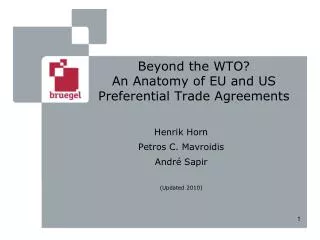
Beyond the WTO? An Anatomy of EU and US Preferential Trade Agreements. Henrik Horn Petros C. Mavroidis André Sapir ( Updated 2010). Motivation for the study. Growing number and scope of PTAs Effect on the multilateral trading system. Two views:
568 views • 23 slides
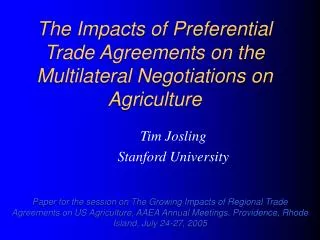
The Impacts of Preferential Trade Agreements on the Multilateral Negotiations on Agriculture. Tim Josling Stanford University. Paper for the session on The Growing Impacts of Regional Trade Agreements on US Agriculture, AAEA Annual Meetings, Providence, Rhode Island, July 24-27, 2005.
541 views • 39 slides
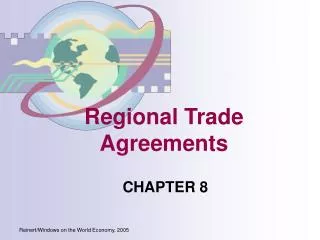
Regional Trade Agreements. CHAPTER 8. Introduction. “Multilateralism” refers to the GATT/WTO system as well as the trade negotiations that take place among all GATT/WTO members as a group Recall that one of the founding principles of this system is nondiscrimination
772 views • 27 slides
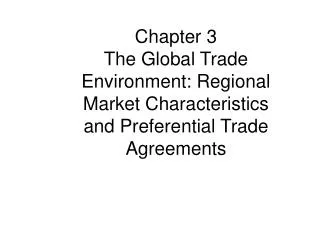 Regional Market Characteristics and Preferential Trade Agreements" width="320px" />
Regional Market Characteristics and Preferential Trade Agreements" width="320px" />
Chapter 3 The Global Trade Environment: Regional Market Characteristics and Preferential Trade Agreements. GATT. General Agreement on Tariffs and Trade treaty among nations to promote trade among members Handled trade disputes Lacked enforcement power
1.19k views • 27 slides
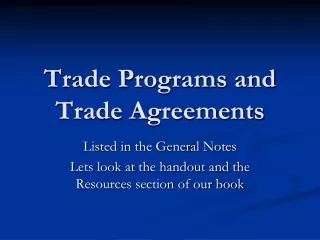
Trade Programs and Trade Agreements. Listed in the General Notes Lets look at the handout and the Resources section of our book. Generalized System of Preferences GSP / GN 4 / CFR 10.171-10.178. Free Duty if the product qualifies for GSP
358 views • 31 slides
 Regional Market Characteristics and Preferential Trade Agreements" width="320px" />
Regional Market Characteristics and Preferential Trade Agreements" width="320px" />
Chapter 3 The Global Trade Environment: Regional Market Characteristics and Preferential Trade Agreements. PowerPoint by Kristopher Blanchard North Central University. GATT. General Agreement on Tariffs and Trade treaty among nations to promote trade among members Handled trade disputes
548 views • 32 slides

Linda Young POLS 400 International Political Economy Wilson Hall – Room 1122. Regional Trade Agreements. Fall 2005. Regional Trade Agreements (RTA). RTA: actions by governments to liberalize or facilitate trade on a regional basis, sometimes through free-trade areas or customs unions
614 views • 42 slides
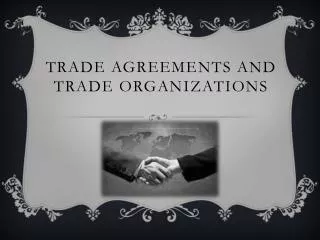
Trade Agreements and Trade Organizations. What is a Trade agreement and a Trade organization?. Trade Agreement: An agreement that governs aspects of trade among countries. Trade Organization:
429 views • 18 slides
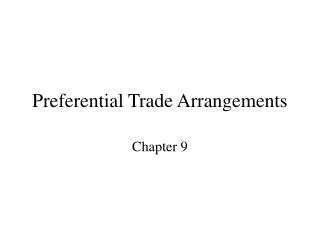
Preferential Trade Arrangements. Chapter 9. Preferential Trade Agreements. Since world war II: trade barriers around the world have fallen significantly International trade have grown significantly
627 views • 5 slides
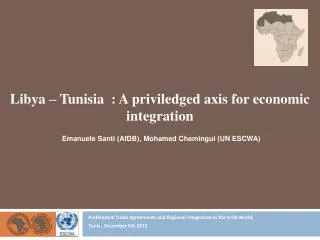
Libya – Tunisia : A priviledged axis for economic integration. Emanuele Santi ( AfDB ), Mohamed Chemingui (UN ESCWA) . Preferential Trade Agreements and Regional Integration in the Arab World, Tunis , December 5th 2012. Outline of the presentation. Introduction
303 views • 19 slides
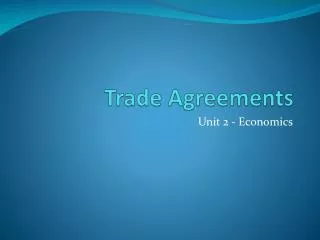
Trade Agreements. Unit 2 - Economics. WTO – World Trade Organization (1994) GATT - General Agreement on Tariffs and Trade . Each agreement was called a round. Organization for liberalizing trade. Negotiating Forum. Set of Rules. Helps settle disputes. 192 countries.
639 views • 15 slides
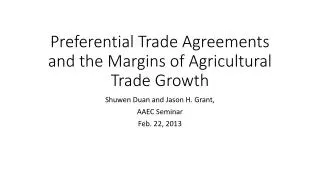
Preferential Trade Agreements and the Margins of Agricultural Trade Growth. Shuwen Duan and Jason H. Grant, AAEC Seminar Feb. 22, 2013. Trade growth in dollar difference. Motivation . Gap in the literature Krugman (1981): over-estimate the extensive margin
318 views • 20 slides

PREFERENTIAL TRADE AGREEMENTS (PTAs) THEORY, EVIDENCE AND POLICY OPTIONS FOR INDIA
403 views • 29 slides
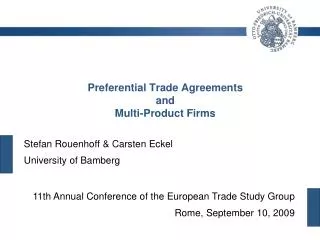
Preferential Trade Agreements and Multi-Product Firms. Stefan Rouenhoff & Carsten Eckel University of Bamberg. 11th Annual Conference of the European Trade Study Group Rome, September 10, 2009. Literature. Preferential trade agreements and FDI
357 views • 18 slides

Preferential Trade Agreements and Multi-Product Firms. Stefan Rouenhoff & Carsten Eckel University of Bamberg. 11th Annual Conference of the European Trade Study Group Rome, September 10, 2009. Literature (1). Preferential trade agreements and FDI
461 views • 30 slides
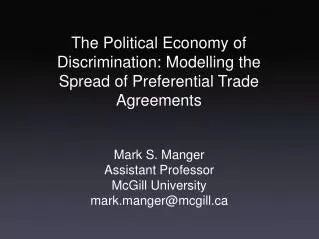
The Political Economy of Discrimination: Modelling the Spread of Preferential Trade Agreements. Mark S. Manger Assistant Professor McGill University mark.manger@mcgill.ca. Research Question. What explains the geographic variation in the spread of PTAs?.
210 views • 11 slides
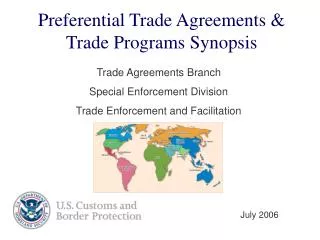
Preferential Trade Agreements & Trade Programs Synopsis. Trade Agreements Branch Special Enforcement Division Trade Enforcement and Facilitation. July 2006. African Growth and Opportunity Act. GN 16. General Notes Reference.
611 views • 38 slides
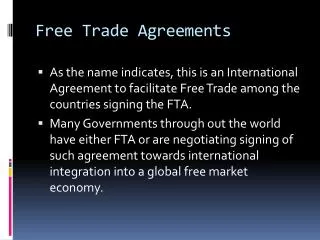
Free Trade Agreements. As the name indicates, this is an International Agreement to facilitate Free Trade among the countries signing the FTA.
498 views • 10 slides
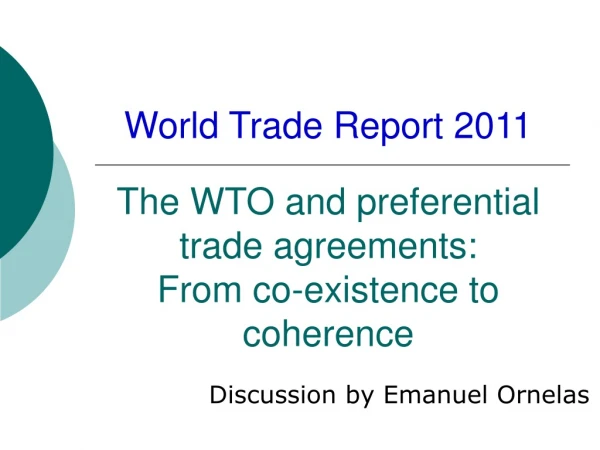
The WTO and preferential trade agreements: From co-existence to coherence. World Trade Report 2011. Discussion by Emanuel Ornelas. Jaime de Melo’s “Remarks at the WTO Report Launch 2010”.
361 views • 34 slides

Free Trade Agreements. Free Trade Agreements. Why Bother?. International Institutions. - WTO Predecessor of GATT Mission to increase and facilitate free and fair trade 164 Members Common Rules on Trade Related Issues Binding Decisions
118 views • 7 slides
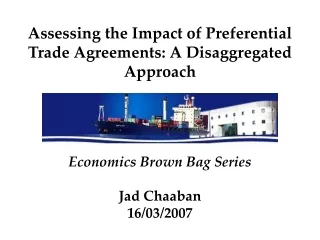
Assessing the Impact of Preferential Trade Agreements: A Disaggregated Approach. Economics Brown Bag Series Jad Chaaban 16/03/2007. Let me start by a story. A Lebanese policy maker asks you, a professional economist, for advice on the following:
294 views • 26 slides

Beyond the WTO? An Anatomy of EU and US Preferential Trade Agreements. Henrik Horn Petros C. Mavroidis André Sapir ( Updated 2010). Motivation for the study. Growing number and scope of PTAs Effect on the multilateral trading system. Two views:
240 views • 23 slides